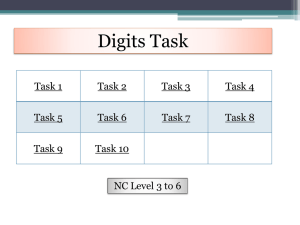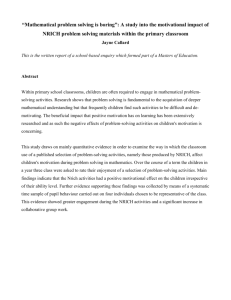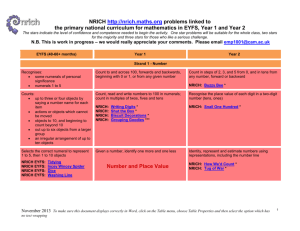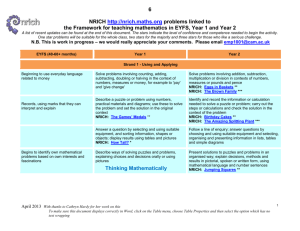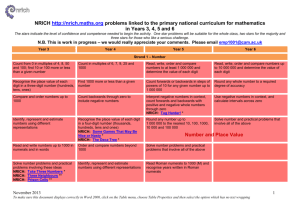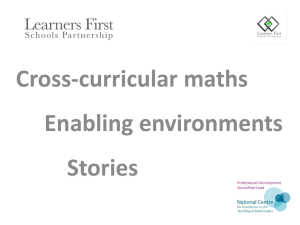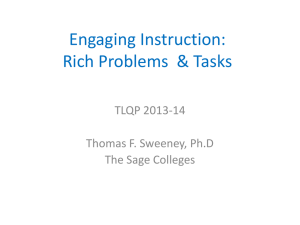KS2FrameworkLinkedtoNRICHSep14
advertisement
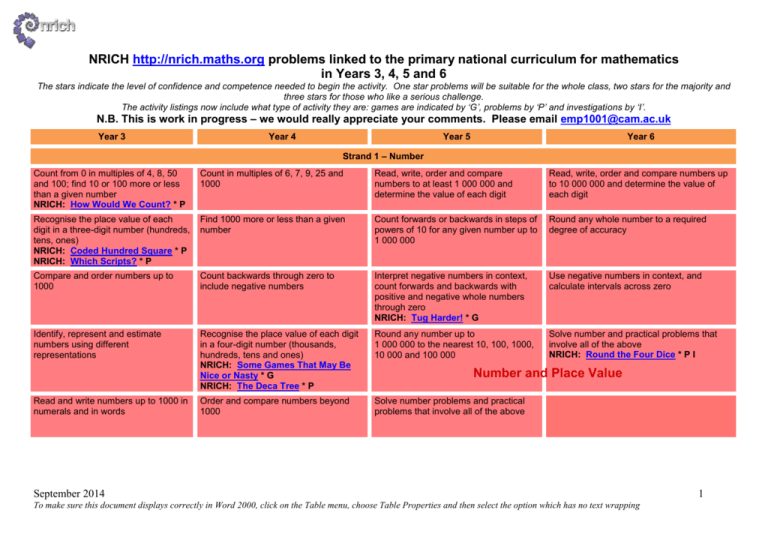
NRICH http://nrich.maths.org problems linked to the primary national curriculum for mathematics in Years 3, 4, 5 and 6 The stars indicate the level of confidence and competence needed to begin the activity. One star problems will be suitable for the whole class, two stars for the majority and three stars for those who like a serious challenge. The activity listings now include what type of activity they are: games are indicated by ‘G’, problems by ‘P’ and investigations by ‘I’. N.B. This is work in progress – we would really appreciate your comments. Please email emp1001@cam.ac.uk Year 3 Year 4 Year 5 Year 6 Strand 1 – Number Count from 0 in multiples of 4, 8, 50 and 100; find 10 or 100 more or less than a given number NRICH: How Would We Count? * P Count in multiples of 6, 7, 9, 25 and 1000 Read, write, order and compare numbers to at least 1 000 000 and determine the value of each digit Read, write, order and compare numbers up to 10 000 000 and determine the value of each digit Recognise the place value of each digit in a three-digit number (hundreds, tens, ones) NRICH: Coded Hundred Square * P NRICH: Which Scripts? * P Find 1000 more or less than a given number Count forwards or backwards in steps of powers of 10 for any given number up to 1 000 000 Round any whole number to a required degree of accuracy Compare and order numbers up to 1000 Count backwards through zero to include negative numbers Interpret negative numbers in context, count forwards and backwards with positive and negative whole numbers through zero NRICH: Tug Harder! * G Use negative numbers in context, and calculate intervals across zero Identify, represent and estimate numbers using different representations Recognise the place value of each digit in a four-digit number (thousands, hundreds, tens and ones) NRICH: Some Games That May Be Nice or Nasty * G NRICH: The Deca Tree * P Round any number up to 1 000 000 to the nearest 10, 100, 1000, 10 000 and 100 000 Solve number and practical problems that involve all of the above NRICH: Round the Four Dice * P I Order and compare numbers beyond 1000 Solve number problems and practical problems that involve all of the above Read and write numbers up to 1000 in numerals and in words Number and Place Value September 2014 To make sure this document displays correctly in Word 2000, click on the Table menu, choose Table Properties and then select the option which has no text wrapping 1 Solve number problems and practical problems involving these ideas NRICH: Take Three Numbers * I NRICH: Three Neighbours ** I NRICH: Prison Cells ** G P NRICH: Spot Thirteen * G P NRICH: Square Subtraction *** I NRICH: Planning a School Trip * p NRICH: Magic Vs ** P NRICH: Number Differences * G P NRICH: Sitting Round the Party Tables * P NRICH: Dotty Six * G NRICH: Nim-7 * G NRICH: Number Match * G NRICH: Cubes Here and There * I NRICH: A Mixed-up Clock * P Identify, represent and estimate numbers using different representations Read Roman numerals to 1000 (M) and recognise years written in Roman numerals Round any number to the nearest 10, 100 or 1000 Solve number and practical problems that involve all of the above and with increasingly large positive numbers Read Roman numerals to 100 (I to C) and know that over time, the numeral system changed to include the concept of zero and place value Add and subtract numbers mentally, including: a three-digit number and ones a three-digit number and tens a three-digit number and hundreds NRICH: How Do You See it? * P NRICH: Swimming Pool* P NRICH: First Connect Three * G P NRICH: Sea Level * P I Add and subtract numbers with up to 4 digits using the formal written methods of columnar addition and subtraction where appropriate Add and subtract whole numbers with more than 4 digits, including using formal written methods (columnar addition and subtraction) Addition and Subtraction September 2014 To make sure this document displays correctly in Word 2000, click on the Table menu, choose Table Properties and then select the option which has no text wrapping 2 NRICH: A Bit of a Dicey Problem *** P NRICH: Totality * G Add and subtract numbers with up to three digits, using formal written methods of columnar addition and subtraction Estimate and use inverse operations to check answers to a calculation Add and subtract numbers mentally with increasingly large numbers Estimate the answer to a calculation and use inverse operations to check answers Solve addition and subtraction two-step problems in contexts, deciding which operations and methods to use and why NRICH: The Puzzling Sweet Shop ** P NRICH: Money Bags ** P NRICH: Amy’s Dominoes ** P NRICH: Escape from the Castle ** P NRICH: Fifteen Cards * P I NRICH: Sealed Solution ** P NRICH: Roll These Dice ** I Use rounding to check answers to calculations and determine, in the context of a problem, levels of accuracy Solve problems, including missing number problems, using number facts, place value, and more complex addition and subtraction NRICH: A Square of Numbers * G P NRICH: Buying a Balloon * P NRICH: GOT IT ** G NRICH: Make 37 ** P NRICH: Consecutive Numbers ** P I NRICH: Super Shapes * P NRICH: Strike it Out * G NRICH: Dice in a Corner *** P I NRICH: Domino Square ** P Solve addition and subtraction multi-step problems in contexts, deciding which operations and methods to use and why NRICH: Twenty Divided Into Six ** P NRICH: Reach 100 *** P NRICH: Two and Two *** P I NRICH: Journeys in Numberland * I NRICH: Maze 100 ** P September 2014 To make sure this document displays correctly in Word 2000, click on the Table menu, choose Table Properties and then select the option which has no text wrapping 3 Recall and use multiplication and division facts for the 3, 4 and 8 multiplication tables NRICH: Ordering Cards * G P NRICH: Music to My Ears * P I Recall multiplication and division facts for multiplication tables up to 12x12 NRICH: Multiplication Square Jigsaw *GP NRICH: Shape Times Shape * P NRICH: Table Patterns Go Wild! ** I NRICH: Let’s Divide Up! * P NRICH: That Number Square! * I NRICH: Carrying Cards * P NRICH: Light the Lights Again * G P NRICH: Multiples Grid * I NRICH: Zios and Zepts * P NRICH: Times Tables Shifts * G P Identify multiples and factors, including all factor pairs of a number, and common factors of two numbers NRICH: Sweets in a Box * P I NRICH: Which Is Quicker? * P NRICH: Multiplication Squares * P I NRICH: Flashing Lights * P NRICH: Abundant Numbers * I NRICH: Factor Track ** G P NRICH: Factors and Multiples Game * G NRICH: Pebbles ** I Multiply multi-digit numbers up to 4 digits by a two-digit whole number using the formal written method of long multiplication Write and calculate mathematical statements for multiplication and division using the multiplication tables that they know, including for two-digit numbers times one-digit numbers, using mental and progressing to formal written methods Use place value, known and derived facts to multiply and divide mentally, including: multiplying by 0 and 1; dividing by 1; multiplying together three numbers NRICH: Trebling * P NRICH: All the Digits ** P Know and use the vocabulary of prime numbers, prime factors and composite (non-prime) numbers NRICH: Two Primes Make One Square ** I Divide numbers up to 4 digits by a two-digit whole number using the formal written method of long division, and interpret remainders as whole number remainders, fractions, or by rounding, as appropriate for the context Solve problems, including missing number problems, involving multiplication and division, including positive integer scaling problems and correspondence problems in which n objects are connected to m objects NRICH: A Square of Numbers * G P NRICH: What do you Need? * P NRICH: This Pied Piper of Hamelin ** P NRICH: Follow the Numbers * P I NRICH: What's in the Box? * P NRICH: How Do You Do It? * P NRICH: Ip Dip * I Recognise and use factor pairs and commutativity in mental calculations Establish whether a number up to 100 is prime and recall prime numbers up to 19 Divide numbers up to 4 digits by a two-digit number using the formal written method of short division where appropriate, interpreting remainders according to the context Multiply two-digit and three-digit numbers by a one-digit number using formal written layout Multiply numbers up to 4 digits by a oneor two-digit number using a formal written method, including long multiplication for two-digit numbers Perform mental calculations, including with mixed operations and large numbers NRICH: Exploring Number Patterns You Make ** P I Multiplication and Division September 2014 To make sure this document displays correctly in Word 2000, click on the Table menu, choose Table Properties and then select the option which has no text wrapping 4 NRICH: Become Maths Detectives * P I Solve problems involving multiplying and adding, including using the distributive law to multiply two digit numbers by one digit, integer scaling problems and harder correspondence problems such as n objects are connected to m objects Multiply and divide numbers mentally drawing upon known facts Identify common factors, common multiples and prime numbers NRICH: Mystery Matrix ** P I NRICH: Factor Lines ** P I NRICH: Factor-multiple Chains ** P NRICH: The Moons of Vuvv * P NRICH: Round and Round the Circle ** P I NRICH: Counting Cogs ** P Divide numbers up to 4 digits by a onedigit number using the formal written method of short division and interpret remainders appropriately for the context Use their knowledge of the order of operations to carry out calculations involving the four operations Multiply and divide whole numbers and those involving decimals by 10, 100 and 1000 Solve addition and subtraction multi-step problems in contexts, deciding which operations and methods to use and why Recognise and use square numbers and cube numbers, and the notation for squared (²) and cubed (³) NRICH: Up and Down Staircases * P NRICH: One Wasn’t Square ** P NRICH: Cycling Squares ** P NRICH: Picture a Pyramid … ** P Solve problems involving addition, subtraction, multiplication and division Solve problems involving multiplication and division including using their knowledge of factors and multiples, squares and cubes NRICH: Curious Number *** P I NRICH: Division Rules * P I Use estimation to check answers to calculations and determine, in the context of a problem, an appropriate degree of accuracy NRICH: Four Go * G September 2014 To make sure this document displays correctly in Word 2000, click on the Table menu, choose Table Properties and then select the option which has no text wrapping 5 Solve problems involving addition, subtraction, multiplication and division and a combination of these, including understanding the meaning of the equals sign NRICH: Make 100 ** P I NRICH: Multiply Multiples 1 * I NRICH: Multiply Multiples 2 * I NRICH: Multiply Multiples 3 * I NRICH: Highest and Lowest * P I NRICH: Four Goodness Sake *** P Solve problems involving multiplication and division, including scaling by simple fractions and problems involving simple rates Count up and down in tenths; recognise that tenths arise from dividing an object into 10 equal parts and in dividing one-digit numbers or quantities by 10 Recognise and show, using diagrams, families of common equivalent fractions NRICH: Fractional Triangles * P NRICH: Bryony’s Triangle * P NRICH: Fair Feast * P Compare and order fractions whose denominators are all multiples of the same number Use common factors to simplify fractions; use common multiples to express fractions in the same denomination Recognise, find and write fractions of a discrete set of objects: unit fractions and non-unit fractions with small denominators NRICH: Fraction Match * G Count up and down in hundredths; recognise that hundredths arise when dividing an object by one hundred and dividing tenths by ten Identify, name and write equivalent fractions of a given fraction, represented visually, including tenths and hundredths Compare and order fractions, including fractions >1 Recognise and use fractions as numbers: unit fractions and non-unit fractions with small denominators Solve problems involving increasingly harder fractions to calculate quantities, and fractions to divide quantities, including non-unit fractions where the answer is a whole number NRICH: Fractions in a Box ** P NRICH: Chocolate ** P I Recognise mixed numbers and improper fractions and convert from one form to the other and write mathematical statements > 1 as a mixed number (e.g. 2/5 + 4/5 = 6/5 = 1 1/5) NRICH: Balance of Halves * P Add and subtract fractions with different denominators and mixed numbers, using the concept of equivalent fractions Add and subtract fractions with the same denominator Add and subtract fractions with the same denominator and denominators that are multiples of the same number Recognise and show, using diagrams, equivalent fractions with small denominators NRICH: Matching Fractions * G Fractions, Decimals, Percentages, Ratio and Proportion Multiply simple pairs of proper fractions, writing the answer in its simplest form [for example, ¼ x ½ = 1/8] September 2014 To make sure this document displays correctly in Word 2000, click on the Table menu, choose Table Properties and then select the option which has no text wrapping 6 Add and subtract fractions with the same denominator within one whole [for example, 5/7 + 1/7 = 6/7] Recognise and write decimal equivalents of any number of tenths or hundredths Multiply proper fractions and mixed numbers by whole numbers, supported by materials and diagrams Divide proper fractions by whole numbers [for example, 1/3 ÷ 2 = 1/6] NRICH: Andy’s Marbles ** P Compare and order unit fractions, and fractions with the same denominators Recognise and write decimal equivalents to ¼; ½; ¾ Read and write decimal numbers as fractions (e.g. 0.71 = 71/100) Associate a fraction with division and calculate decimal fraction equivalents [for example, 0.375] for a simple fraction [for example, 3/8] Solve problems that involve all of the above Find the effect of dividing a one- or twodigit number by 10 and 100, identifying the value of the digits in the answer as ones, tenths and hundredths Recognise and use thousandths and relate them to tenths, hundredths and decimal equivalents Identify the value of each digit in numbers given to three decimal places and multiply and divide numbers by 10, 100 and 1000 giving answers up to three decimal places Round decimals with one decimal place to the nearest whole number Round decimals with two decimal places to the nearest whole number and to one decimal place NRICH: Round the Dice Decimals 1 * PI NRICH: Round the Dice Decimals 2 * Multiply one-digit numbers with up to two decimal places by whole numbers Compare numbers with the same number of decimal places up to two decimal places Read, write, order and compare numbers with up to three decimal places NRICH: Greater Than or Less Than? * I NRICH: Spiralling Decimals *** G Use written division methods in cases where the answer has up to two decimal places Solve simple measure and money problems involving fractions and decimals to two decimal places Solve problems involving number up to three decimal places NRICH: Route Product ** P I NRICH: Forgot the Numbers ** I Solve problems which require answers to be rounded to specified degrees of accuracy Recognise the per cent symbol (%) and understand that per cent relates to “number of parts per hundred”, and write percentages as a fraction with denominator 100, and as a decimal Recall and use equivalences between simple fractions, decimals and percentages, including in different contexts Solve problems which require knowing percentage and decimal equivalents of ½, ¼, 1/5, 2/5, 4/5 and those fractions with a denominator a multiple of 10 or September 2014 To make sure this document displays correctly in Word 2000, click on the Table menu, choose Table Properties and then select the option which has no text wrapping 7 25 Solve problems involving the relative sizes of two quantities where missing values can be found by using integer multiplication and division facts NRICH: Orange Drink ** P NRICH: Pumpkin Pie Problem ** P NRICH: Jumping * P Solve problems involving the calculation of percentages [for example, of measures, and such as 15% of 360] and the use of percentages for comparison NRICH: Would you Rather? * P Solve problems involving similar shapes where the scale factor is known or can be found Solve problems involving unequal sharing and grouping using knowledge of fractions and multiples Use simple formulae Generate and describe linear number sequences NRICH: Domino Sets * P I Express missing number problems algebraically NRICH: Plenty of Pens * P Find pairs of numbers that satisfy an equation with two unknowns Algebra Year 3 Year 4 Year 5 Enumerate possibilities of combinations of two variables Year 6 September 2014 To make sure this document displays correctly in Word 2000, click on the Table menu, choose Table Properties and then select the option which has no text wrapping 8 Strand 2 - Measurement Measure, compare, add and subtract: lengths (m/cm/mm); mass (kg/g); volume/capacity (l/ml) NRICH: Olympic Starters * I NRICH: Car Journey * I Convert between different units of measure [for example, kilometre to metre; hour to minute] Convert between different units of metric measure [for example, kilometre and metre; centimetre and metre; centimetre and millimetre; gram and kilogram; litre and millilitre] Solve problems involving the calculation and conversion of units of measure, using decimal notation up to three decimal places where appropriate Measure the perimeter of simple 2-D shapes Measure and calculate the perimeter of a rectilinear figure (including squares) in centimetres and metres Understand and use approximate equivalences between metric units and common imperial units such as inches, pounds and pints Use, read, write and convert between standard units, converting measurements of length, mass, volume and time from a smaller unit of measure to a larger unit, and vice versa, using decimal notation up to three decimal places Add and subtract amounts of money to give change, using both £ and p in practical contexts Find the area of rectilinear shapes by counting squares NRICH: Torn Shapes * P I Measure and calculate the perimeter of composite rectilinear shapes in centimetres and metres NRICH: Area and Perimeter * I NRICH: Through the Window * I Convert between miles and kilometres Tell and write the time from an analogue clock, including using Roman numerals from I to XII, and 12hour and 24-hour clocks NRICH: Two Clocks ** P NRICH: Clocks * P NRICH: The Time Is … ** P NRICH: How Many Times? * I NRICH: 5 on the Clock *** I Estimate, compare and calculate different measures, including money in pounds and pence NRICH: Discuss and Choose * P Calculate and compare the area of rectangles (including squares), and including using standard units, square centimetres (cm2) and square metres (m2) and estimate the area of irregular shapes NRICH: Numerically Equal ** P NRICH: Shaping It * I NRICH: Cubes * P I NRICH: Fitted *** P NRICH: Brush Loads * P I NRICH: Making Boxes ** I NRICH: Through the Window * I Recognise that shapes with the same areas can have different perimeters and vice versa NRICH: Dicey Perimeter, Dicey Area * G Estimate and read time with increasing accuracy to the nearest minute; record and compare time in terms of seconds, minutes and hours; use vocabulary such as o’clock, a.m./p.m., morning, afternoon, noon and midnight NRICH: Wonky Watches ** P Read, write and convert time between analogue and digital 12- and 24-hour clocks Estimate volume [for example, using 1 cm³ blocks to build cuboids (including cubes)] and capacity [for example, using water] Recognise when it is possible to use formulae for area and volume of shapes September 2014 To make sure this document displays correctly in Word 2000, click on the Table menu, choose Table Properties and then select the option which has no text wrapping 9 NRICH: Watch the Clock *** P Know the number of seconds in a minute and the number of days in each month, year and leap year Solve problems involving converting from hours to minutes; minutes to seconds; years to months; weeks to days Compare durations of events [for example to calculate the time taken by particular events or tasks] Year 3 Solve problems involving converting between units of time Calculate the area of parallelograms and triangles Use all four operations to solve problems involving measure [e.g. length, mass, volume, money] using decimal notation, including scaling Calculate, estimate and compare volume of cubes and cuboids using standard units, including cubic centimetres (cm³) and cubic metres (m³), and extending to other units [for example, mm³ and km³] NRICH: Next Size Up ** P Year 5 Year 6 Year 4 Strand 3 – Geometry Draw 2-D shapes and make 3-D shapes using modelling materials; recognise 3-D shapes in different orientations and describe them NRICH: Building Blocks * P NRICH: The Third Dimension *** P I NRICH: Rolling That Cube * P NRICH: Inky Cube *** P NRICH: Triple Cubes * I NRICH: Sponge Sections ** P NRICH: A Puzzling Cube * P NRICH: Arranging Cubes * G NRICH: Board Block Challenge *** G NRICH: Square Corners ** P NRICH: Stick Images * G P Compare and classify geometric shapes, including quadrilaterals and triangles, based on their properties and sizes NRICH: Nine-pin Triangles *** I NRICH: Cut it Out *** P NRICH: Sorting Logic Blocks * G NRICH: What Shape? * G P Identify 3-D shapes, including cubes and other cuboids, from 2-D representations Recognise angles as a property of shape or a description of a turn Identify acute and obtuse angles and compare and order angles up to two right angles by size Know angles are measured in degrees; estimate and compare acute, obtuse and reflex angles Draw 2-D shapes using given dimensions and angles NRICH: Making Spirals *** P NRICH: Shape Draw * P Properties of Shapes Recognise, describe and build simple 3-D shapes, including making nets NRICH: Cut Nets ** P NRICH: Making Cuboids ** P I September 2014 To make sure this document displays correctly in Word 2000, click on the Table menu, choose Table Properties and then select the option which has no text wrapping 10 Identify right angles, recognise that two right angles make a half-turn, three make three quarters of a turn and four a complete turn; identify whether angles are greater than or less than a right angle NRICH: Square It * G Identify lines of symmetry in 2-D shapes presented in different orientations NRICH: Let’s Reflect * P NRICH: National Flags * P NRICH: Stringy Quads ** P NRICH: Bracelets * I NRICH: Counters in the Middle * G P Draw given angles, and measure them in degrees (°) NRICH: The Numbers Give the Design * I NRICH: Six Places to Visit * P NRICH: How Safe Are You? * P NRICH: Olympic Turns *** P Compare and classify geometric shapes based on their properties and sizes and find unknown angles in any triangles, quadrilaterals, and regular polygons NRICH: Where Are They? * P NRICH: Quadrilaterals *** P I NRICH: Round a Hexagon * P Identify horizontal and vertical lines and pairs of perpendicular and parallel lines NRICH: National Flags * P Complete a simple symmetric figure with respect to a specific line of symmetry NRICH: A Cartesian Puzzle * P NRICH: Symmetry Challenge *** I NRICH: Coordinate Challenge * P NRICH: School Fair Necklaces ** I Identify: angles at a point and one whole turn (total 360°) angles at a point on a straight line and ½ a turn (total 180°) other multiples of 90° Illustrate and name parts of circles, including radius, diameter and circumference and know that the diameter is twice the radius Use the properties of rectangles to deduce related facts and find missing lengths and angles Recognise angles where they meet at a point, are on a straight line, or are vertically opposite, and find missing angles Distinguish between regular and irregular polygons based on reasoning about equal sides and angles NRICH: Egyptian Rope ** P I Describe positions on a 2-D grid as coordinates in the first quadrant Describe movements between positions as translations of a given unit to the left/right and up/down Identify, describe and represent the position of a shape following a reflection or translation, using the appropriate language, and know that the shape has not changed NRICH: Transformations on a Pegboard * P NRICH: Square Corners ** I NRICH: More Transformations on a Pegboard ** P I Describe positions on the full coordinate grid (all four quadrants) NRICH: Cops and Robbers * G NRICH: Eight Hidden Squares ** P NRICH: Coordinate Tan ** P NRICH: Ten Hidden Squares *** P Position and Direction Draw and translate simple shapes on the coordinate plane, and reflect them in the axes September 2014 To make sure this document displays correctly in Word 2000, click on the Table menu, choose Table Properties and then select the option which has no text wrapping 11 Plot specified points and draw sides to complete a given polygon. Year 3 Year 4 Year 5 Year 6 Strand 4 - Statistics Interpret and present data using bar charts, pictograms and tables NRICH: Our Sports * I NRICH: Class 5’s Names * P NRICH: Going for Gold * I NRICH: The Domesday Project * I NRICH: The Car That Passes * I NRICH: Now and Then ** P NRICH: Real Statistics *** P NRICH: If the World Were a Village *P NRICH: It's a Tie ** I Interpret and present discrete and continuous data using appropriate graphical methods, including bar charts and time graphs Solve comparison, sum and difference problems using information presented in a line graph Interpret and construct pie charts and line graphs and use these to solve problems NRICH: Match the Matches ** P Solve one-step and two-step questions [for example, ‘How many more?’ and ‘How many fewer?’] using information presented in scaled bar charts and pictograms and tables NRICH: The Olympic Flame: Are You in the 95%? * P Solve comparison, sum and difference problems using information presented in bar charts, pictograms, tables and other graphs NRICH: Venn Diagrams * P NRICH: More Carroll Diagrams * P NRICH: Plants ** I Complete, read and interpret information in tables, including timetables Calculate and interpret the mean as an average NRICH: Birdwatch * I NRICH: Probably … * P NRICH: Odds or Sixes? * G NRICH: Same or Different? ** G NRICH: Tricky Track ** G NRICH: Winning the Lottery ** P September 2014 To make sure this document displays correctly in Word 2000, click on the Table menu, choose Table Properties and then select the option which has no text wrapping 12

